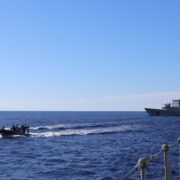Let’s face it: A true EEZ is impossible in South China Sea
To begin with, there virtually seem to be some mists of unintended deception—if I may be allowed to call it so—when we speak of exclusive economic zone (EEZ) as it relates to a built-in constraint invariably obtained in the South China Sea (SCS).As defined under the United Nations Convention on the Law of the Sea (Unclos) in 1982, EEZ refers to an area of the ocean extending up to 200 nautical miles immediately offshore from a country’s land coast, in which the country maintains exclusive rights to the exploration and exploitation of natural resources. The introduction of EEZ extended the traditionally respected boundary of territorial waters which had been set at 12 nautical miles from the coast during the first Unclos (1958). Whether such an extension enhanced or worsened the relationships among nations in the SCS, I do not wish to second-guess.
Let it suffice for me to state that a little research on this matter reveals the coast-to-coast distance among most countries in the SCS to seldom exceed 400 nautical miles. It is then natural to expect the respective 200-mile EEZ allocated each to China, the Philippines, Vietnam, Malaysia, Indonesia, and Brunei to overlap with one another. To put it more clearly, the boundary of one EEZ will always unavoidably touch, or worse, extend beyond, the boundary of another EEZ. This is the built-in constraint I earlier mentioned. Given the overlapping EEZs, plain common sense would outright insist that there can never be a truly “exclusive” economic zone in the SCS. To be honest, even so, not one of the SCS countries may indeed be totally faulted for viciously claiming all the marine resources inside the overlapping zones. Alas, I know this impression is highly unthinkable! But that is beside the point.
The point is, President Marcos has been quoted in the media as saying there is a need for a paradigm shift in the SCS issue owing to the failure of the Philippines’ past diplomatic efforts with China. That is certainly good news, although no one yet knows exactly what foreign relations strategy freshly dwells in his mind. Whatsoever that may be, it must necessarily lead once and for all to some kind of modus vivendi that is essentially characterized by mutually honest-to-goodness sharing and joint exploration of the bounties of the sea. Incidentally, we should not let pass unnoticed that Vietnam and Indonesia have been known for years to be moving in the same direction, too, without much ado. At the very least, this is kind of reassuring.
Indeed, this government must struggle at all costs to take advantage of every emerging opportunity to pursue and achieve the above-mentioned goal. I refuse to believe that China would in conscience remain forever against it, recalling that sometime in the not-so-distant past it had allowed Filipino fishermen to freely fish near the EEZs being claimed in common by China and the Philippines, albeit then on a relatively off-and-on basis. Methinks the time has come for such cooperative interrelations to be formally repursued in a manner that effectively bypasses difficulties. Then, only then, may we optimistically assure ourselves of the beginning of the only logical solution—well, other than war—to the two countries’ heretofore unending disputes.
RUDY CORONEL,
Batangas City















